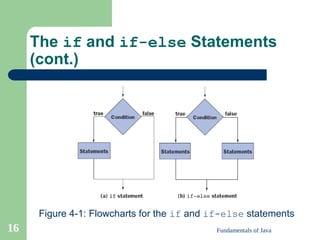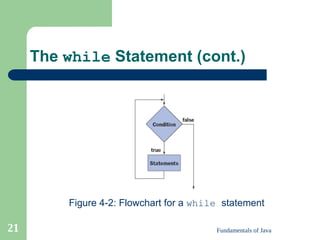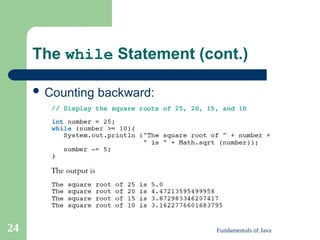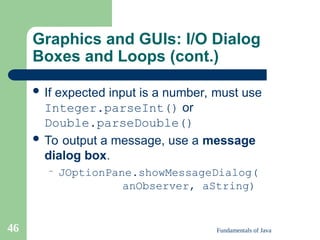Control statements in Java Programming Language
- 1. Chapter 4 Introduction to Control Statements Fundamentals of Java
- 2. Fundamentals of Java 2 Objectives Use the increment and decrement operators. Use standard math methods. Use if and if-else statements to make choices.
- 3. Fundamentals of Java 3 Objectives (cont.) Use while and for loops to repeat a process. Construct appropriate conditions for control statements using relational operators. Detect and correct common loop errors.
- 4. Fundamentals of Java 4 Vocabulary Control statements Counter Count-controlled loop Entry-controlled loop Flowchart Infinite loop
- 5. Fundamentals of Java 5 Vocabulary (cont.) Iteration Off-by-one error Overloading Sentinel Task-controlled loop
- 6. Fundamentals of Java 6 Additional Operators Extended assignment operators – Assignment operator combined with arithmetic and concatenation operators
- 7. Fundamentals of Java 7 Additional Operators (cont.) Increment operator: ++ – Increase value of operand by 1 Decrement operator: -- – Decrease value of operand by 1
- 8. Fundamentals of Java 8 Standard Classes and Methods: The Math Class Table 4-1: Seven methods in the Math class
- 9. Fundamentals of Java 9 Standard Classes and Methods: The Math Class (cont.) The two abs() methods are overloaded. – Overloaded: Multiple methods in the same class with the same name Using sqrt() method example:
- 10. Fundamentals of Java 10 Standard Classes and Methods: The Math Class (cont.) Math class methods example:
- 11. Fundamentals of Java 11 Standard Classes and Methods: The Random Class Random number generator: Returns numbers chosen at random from a pre- designated interval Table 4-2: Methods in the Random class
- 12. Fundamentals of Java 12 A Visit to the Farm
- 13. Fundamentals of Java 13 The if and if-else Statements Principal forms:
- 14. Fundamentals of Java 14 The if and if-else Statements (cont.) Additional forms:
- 15. Fundamentals of Java 15 The if and if-else Statements (cont.) Better to over-use braces than under-use them – Can help to eliminate logic errors Condition of an if statement must be a Boolean expression – Evaluates to true or false A flowchart can be used to illustrate the behavior of if-else statements.
- 16. Fundamentals of Java 16 The if and if-else Statements (cont.) Figure 4-1: Flowcharts for the if and if-else statements
- 17. Fundamentals of Java 17 The if and if-else Statements (cont.) Examples of if statements:
- 18. Fundamentals of Java 18 The if and if-else Statements (cont.) Table 4-3: Relational operators
- 19. Fundamentals of Java 19 The if and if-else Statements (cont.): Checking Input for Validity Example 4.1: Computes the area of a circle if the radius >= 0 or otherwise displays an error message
- 20. Fundamentals of Java 20 The while Statement Provides a looping mechanism – Executes statements repeatedly for as long as some condition remains true
- 21. Fundamentals of Java 21 The while Statement (cont.) Figure 4-2: Flowchart for a while statement
- 22. Fundamentals of Java 22 The while Statement (cont.) Example: Counter-controlled loop: – cntr is the counter – Loop repeats a determined number of times
- 23. Fundamentals of Java 23 The while Statement (cont.) Tracing: Track value of variables through each iteration of the loop Table 4-4: Trace of how variables change on each iteration through a loop
- 24. Fundamentals of Java 24 The while Statement (cont.) Counting backward:
- 25. Fundamentals of Java 25 The while Statement (cont.) Task-controlled loop: Continues to execute until some task is accomplished
- 26. Fundamentals of Java 26 The while Statement (cont.) Common structure of a while loop:
- 27. Fundamentals of Java 27 The while Statement (cont.) Example 4.2: Compute and display the factorial of n
- 28. Fundamentals of Java 28 The for statement Combines counter initialization, condition test, and update into a single expression Easy to create count-controlled loops
- 29. Fundamentals of Java 29 The for statement (cont.) Example:
- 30. Fundamentals of Java 30 The for statement (cont.) Count-controlled input:
- 31. Fundamentals of Java 31 The for statement (cont.) Better to declare the loop control variable within the loop header – Only visible within the loop – Variable name can be reused later in other loops
- 32. Fundamentals of Java 32 The for statement (cont.) Both for loops and while loops are entry- controlled loops. – Condition tested at top of loop on each pass Choosing a for loop versus a while loop is often a matter of style. – for loop advantages: Can declare loop control variable in header Initialization, condition, and update in one line of code
- 33. Fundamentals of Java 33 Nested Control Statements and the break Statement Control statements may be nested.
- 34. Fundamentals of Java 34 Nested Control Statements and the break Statement (cont.) break statement: Prematurely end a loop
- 35. Fundamentals of Java 35 Nested Control Statements and the break Statement (cont.) Sentinel-controlled input: Continue a loop until a sentinel variable has a specific value
- 36. Fundamentals of Java 36 Using Loops with Text Files Advantages of using text files versus input from a human user: – Data sets can be much larger. – Data input quickly, with less chance of error. – Data can be used repeatedly. Data files can be created by hand in a text editor or generated by a program.
- 37. Fundamentals of Java 37 Using Loops with Text Files (cont.) Text file format: – If data is numerical, numbers must be separated by white space. – Must be an end-of-file character Used by program to determine whether it is done reading data When an error occurs at run-time, the JVM throws an exception. – IOException thrown if error occurs during file operations
- 38. Fundamentals of Java 38 Using Loops with Text Files (cont.) Example 4.3: Computes and displays the average of a file of floating-point numbers
- 39. Fundamentals of Java 39 Using Loops with Text Files (cont.) Example 4.4: Inputs a text file of integers and writes these to an output file without the zeroes
- 40. Fundamentals of Java 40 Errors in Loops May occur in initializing statements, terminating conditions, body statements, or update statements Initialization error: Failure to initialize or initializes to incorrect value Off-by-one error: Loop iterates one too many or one too few times
- 41. Fundamentals of Java 41 Errors in Loops (cont.) Infinite loop: Error in the terminating condition – Loop never terminates Errors in loop body affect whether the loop completes its task correctly or at all. Update error: Update statements in wrong place may affect calculations – Failing to update at all results in an infinite loop.
- 42. Fundamentals of Java 42 Errors in Loops (cont.) Effects of limited floating-point precision: When using floating-point variables as loop control variables, you must understand that not all values can be represented. – Better not to use == or != in condition statement under these conditions
- 43. Fundamentals of Java 43 Errors in Loops (cont.) Debugging loops: – If an error is suspected, make sure that: Variables are initialized before entering the loop The terminating condition stops the iterations when the test variables have reached the intended limit The statements in the body are correct
- 44. Fundamentals of Java 44 Errors in Loops (cont.) Debugging loops (cont.): – If an error is suspected, make sure that: The update statements are positioned correctly and modify the test variables so that they eventually pass the limits tested in the terminating condition
- 45. Fundamentals of Java 45 Graphics and GUIs: I/O Dialog Boxes and Loops A convenient way to accept input from a user is to pop up an input dialog box. – Use JOptionPane.showInputDialog(). Figure 4-4: Input dialog box
- 46. Fundamentals of Java 46 Graphics and GUIs: I/O Dialog Boxes and Loops (cont.) If expected input is a number, must use Integer.parseInt() or Double.parseDouble() To output a message, use a message dialog box. – JOptionPane.showMessageDialog( anObserver, aString)
- 47. Fundamentals of Java 47 Graphics and GUIs: I/O Dialog Boxes and Loops (cont.) Example 4.5: CircleArea with dialog I/O
- 48. Fundamentals of Java 48 Graphics and GUIs: I/O Dialog Boxes and Loops (cont.) Figure 4.5: Dialog I/O user interface for the circle area program
- 49. Fundamentals of Java 49 Graphics and GUIs: I/O Dialog Boxes and Loops (cont.) Setting up multiple panels: – Can use a loop to initialize and install panels Setting the preferred size of a panel: – Use JPanel class’s setPreferredSize() method. – JFrame class’s pack() method will cause the window to adjust its size to exactly fit the preferred size of any contained panels.
- 50. Fundamentals of Java 50 Graphics and GUIs: I/O Dialog Boxes and Loops (cont.) Example 4-7: Color panel whose background is a color provided by the client. A client-specified preferred size is optional.
- 51. Fundamentals of Java 51 Design, Testing, and Debugging Hints Most errors involving selection statements and loops are not syntax errors. The presence or absence of the {} symbols can seriously affect the logic of a selection statement or loop. When testing programs that use if or if- else statements, use test data that forces the program to exercise all logical branches.
- 52. Fundamentals of Java 52 Design, Testing, and Debugging Hints (cont.) Use an if-else statement rather than two if statements when the alternative courses of action are mutually exclusive. When testing a loop, be sure to use limit values as well as typical values. Be sure to check entry conditions and exit conditions for each loop.
- 53. Fundamentals of Java 53 Design, Testing, and Debugging Hints (cont.) For a loop with errors, use debugging output statements to verify the values of the control variable on each pass through the loop. Text files are convenient to use when the data set is large, when the same data set must be used repeatedly with different programs, and when these data must be saved permanently.
- 54. Fundamentals of Java 54 Summary Java has operators for extended assignment and for increment and decrement. The Math class provides several useful methods, such as sqrt and abs. The Random class allows you to generate random integers and floating-point numbers. if and if-else statements are used to make one-way and two-way decisions.
- 55. Fundamentals of Java 55 Summary (cont.) The comparison operators, such as ==, <=, and >=, return Boolean values that can serve as conditions for control statements. The while loop allows the program to run a set of statements repeatedly until a condition becomes false. The for loop is a more concise version of the while loop.
- 56. Fundamentals of Java 56 Summary (cont.) Other control statements, such as an if statement, can be nested within loops. A break statement can be used with an if statement to terminate a loop early. Many kinds of logic errors can occur in loops. – Off-by-one error – Infinite loop























































